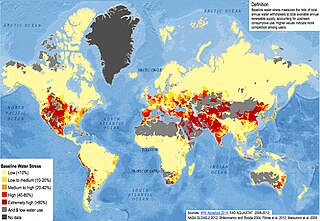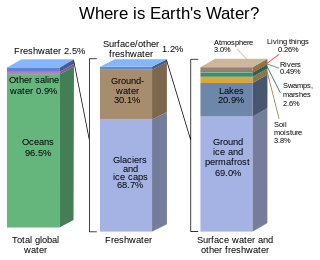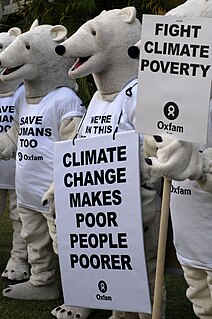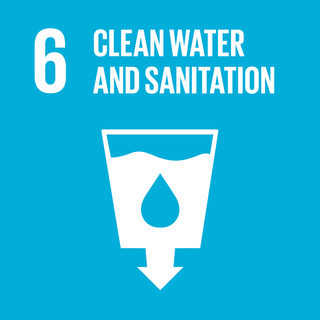
Sanitation refers to public health conditions related to clean drinking water and adequate treatment and disposal of human excreta and sewage. Preventing human contact with feces is part of sanitation, as is hand washing with soap. Sanitation systems aim to protect human health by providing a clean environment that will stop the transmission of disease, especially through the fecal–oral route. For example, diarrhea, a main cause of malnutrition and stunted growth in children, can be reduced through adequate sanitation. There are many other diseases which are easily transmitted in communities that have low levels of sanitation, such as ascariasis, cholera, hepatitis, polio, schistosomiasis, and trachoma, to name just a few.

Drinking water, also known as potable water, is water that is safe to drink or use for food preparation. The amount of drinking water required to maintain good health varies, and depends on physical activity level, age, health-related issues, and environmental conditions. For those who work in a hot climate, up to 16 litres (4.2 US gal) a day may be required.

The International Water Management Institute (IWMI) is a non-profit international water management research organisation under the CGIAR with its headquarters in Colombo, Sri Lanka, and offices across Africa and Asia. Research at the Institute focuses on improving how water and land resources are managed, with the aim of underpinning food security and reducing poverty while safeguarding the environment.
Water resource management is the activity of planning, developing, distributing and managing the optimum use of water resources. It is an aspect of water cycle management.

The water resources of China are affected by both severe water shortages and severe growing population and rapid economic development as well as lax environmental oversight have increased in a large scale the water demand and pollution. China has responded by measures such as rapidly building out the water infrastructure and increasing regulation as well as exploring a number of further technological solutions.

Water politics, sometimes called hydropolitics, is politics affected by the availability of water and water resources, a necessity for all life forms and human development.

Water scarcity is the lack of fresh water resources to meet the standard water demand. Humanity is facing a water crisis, due to unequal distribution resulting in some very wet and some very dry geographic locations, plus a sharp rise in global freshwater demand in recent decades driven by industry. Water scarcity can also be caused by droughts, lack of rainfall, or pollution. This was listed in 2019 by the World Economic Forum as one of the largest global risks in terms of potential impact over the next decade. It is manifested by partial or no satisfaction of expressed demand, economic competition for water quantity or quality, disputes between users, irreversible depletion of groundwater, and negative impacts on the environment. Two-thirds of the global population live under conditions of severe water scarcity at least 1 month of the year. Half a billion people in the world face severe water scarcity all year round. Half of the world's largest cities experience water scarcity.

Peak water is a concept that underlines the growing constraints on the availability, quality, and use of freshwater resources.

Water resources are natural resources of water that are potentially useful as a source of water supply. 97% of the water on the Earth is salt water and only three percent is fresh water; slightly over two thirds of this is frozen in glaciers and polar ice caps. The remaining unfrozen freshwater is found mainly as groundwater, with only a small fraction present above ground or in the air. Natural sources of fresh water include surface water, under river flow, groundwater and frozen water. Artificial sources of fresh water can include treated wastewater and desalinated seawater.

Farm water, also known as agricultural water, is water committed for use in the production of food and fibre and collecting for further resources. In the US, some 80% of the fresh water withdrawn from rivers and groundwater is used to produce food and other agricultural products. Farm water may include water used in the irrigation of crops or the watering of livestock.

Climate change and poverty are deeply intertwined because climate change disproportionally affects poor people in low-income communities and developing countries around the world. Those in poverty have a higher chance of experiencing the ill-effects of climate change due to the increased exposure and vulnerability. Vulnerability represents the degree to which a system is susceptible to, or unable to cope with, adverse effects of climate change including climate variability and extremes.

Water scarcity in Africa is predicted to reach dangerously high levels by 2025. It is estimated that about two-third of the world's population may suffer from fresh water shortage by 2025. The main causes of water scarcity in Africa are physical and economic scarcity, rapid population growth, and climate change. Water scarcity is the lack of fresh water resources to meet the standard water demand. Although Sub-Saharan Africa has a plentiful supply of rainwater, it is seasonal and unevenly distributed, leading to frequent floods and droughts. Additionally, prevalent economic development and poverty issues, compounded with rapid population growth and rural-urban migration have rendered Sub-Saharan Africa as the world's poorest and least developed region.

Water resource policy, sometimes called water resource management or water management, encompasses the policy-making processes and legislation that affect the collection, preparation, use, disposal, and protection of water resources. Water is necessary for all forms of life as well as industries on which humans are reliant, like technology development and agriculture. This global need for clean water access necessitates water resource policy to determine the means of supplying and protecting water resources. Water resource policy varies by region and is dependent on water availability or scarcity, the condition of aquatic systems, and regional needs for water. Since water basins do not align with national borders, water resource policy is also determined by international agreements, also known as hydropolitics. Water quality protection also falls under the umbrella of water resource policy; laws protecting the chemistry, biology, and ecology of aquatic systems by reducing and eliminating pollution, regulating its usage, and improving the quality are considered water resource policy. When developing water resource policies, many different stakeholders, environmental variables, and considerations have to be taken to ensure the health of people and ecosystems are maintained or improved. Finally, ocean zoning, coastal, and environmental resource management are also encompassed by water resource management, like in the instance of offshore wind land leasing.

Water issues in developing countries include scarcity of drinking-water, poor infrastructure for water access, floods and droughts, and the contamination of rivers and large dams. Over one billion people in developing countries have inadequate access to clean water. Barriers to addressing water problems in developing nations include poverty, climate change, and poor governance.

The Water crisis in Iran refers to the problems regarding water scarcity in Iran. Water scarcity can be a result of two mechanisms: physical (absolute) water scarcity and economic water scarcity, where physical water scarcity is a result of inadequate natural water resources to supply a region's demand, and economic water scarcity is a result of poor management of the sufficient available water resources. Iran's main concerns regarding the water crisis include high climatic variability, poor distribution of water, and prioritization of economic development.

Groundwater pollution occurs when pollutants are released to the ground and make their way down into groundwater. This type of water pollution can also occur naturally due to the presence of a minor and unwanted constituent, contaminant or impurity in the groundwater, in which case it is more likely referred to as contamination rather than pollution.

Water in Africa is an important issue encompassing the sources, distribution and economic uses of the water resources on the continent. Overall, Africa has about 9% of the world's fresh water resources and 16% of the world's population. There are about 17 rivers in the African continent.Among these rivers are the Congo, Nile, Zambezi, Niger and Lake Victoria, considered the world’s second largest lake.

Environmental issues in Yemen are abundant and are divided into the categories of land and water. In the aspect of water, Yemen has limited natural fresh water resources and inadequate supplies of potable water. As for the land, two main issues of Yemen are overgrazing and desertification. Yemen has signed several international agreements: Climate Change-Kyoto Protocol, Desertification, Endangered Species, Environmental Modification, Hazardous Wastes, Law of the Sea, and Ozone Layer Protection.

Sustainable Development Goal 6 is about "clean water and sanitation for all". It is one of 17 Sustainable Development Goals established by the United Nations General Assembly in 2015, the official wording is: "Ensure availability and sustainable management of water and sanitation for all." The goal has eight targets to be achieved by at least 2030. Progress toward the targets will be measured by using eleven indicators.

Fresh water or freshwater is any naturally occurring liquid/solid water containing low concentrations of dissolved salts and other total dissolved solids. Although the term specifically excludes seawater and brackish water, it does include non-salty mineral-rich waters such as chalybeate springs. Fresh water may encompass frozen and meltwater in ice sheets, ice caps, glaciers, snowfields and icebergs, natural precipitations such as rainfall, snowfall, hail/sleet and graupel, and surface runoffs that form inland bodies of water such as wetlands, ponds, lakes, rivers, streams, as well as groundwater contained in aquifers, subterranean rivers and lakes.



















